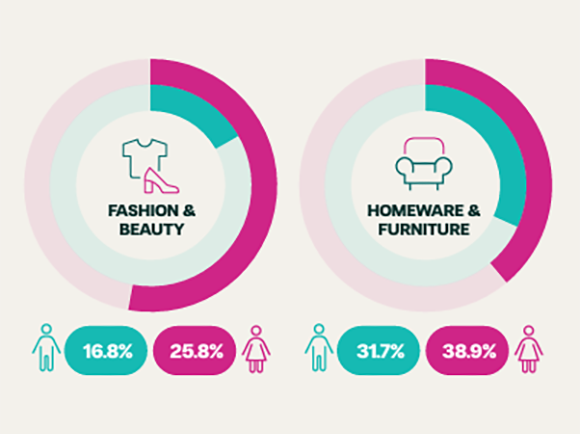Golden Quarter 2023: How will UK shoppers spend this Christmas?

John Lewis made headlines recently for opening their online Christmas store a week early, a result of significantly higher searches for festive items like Christmas wrapping paper (+466%), stockings (+250%) and crackers (400%) than last year. Some pundits have suggested early consumer demand could be a response to the ongoing cost of living crisis.
That may well be the case. Stubborn inflation, rising interest rates and an overall reduction in spending power has led Brits to cut back this year. Shopping early is one way to spread the cost of Christmas over a longer period to reduce the burden. In fact, Tesco urged customers to do exactly that last year at the height of the energy crisis.
This got us thinking: Are consumers really planning to spread the cost of Christmas this year? How much are they planning to spend? And what forms of finance will they use?
That’s why we asked 2,000 UK consumers about their 2023 Christmas shopping plans. What we found is that shoppers are indeed planning to spend earlier this year. They plan to spend the most on gifts (but it’s less than previous years according to similar surveys). And they’re planning to use checkout finance as a key form of financing.
Here are the results.
Over half of UK shoppers plan to do their Christmas shopping on or before Black Friday weekend
According to our survey, over a third (34.5%) of Christmas shoppers plan to make most of their purchases between now and Black Friday weekend, with a further one in five (17.3%) aiming to get most of theirs done on Black Friday weekend itself. That means just over half (51.8%) of UK shoppers plan to complete their shopping before the end of Black Friday weekend.
Perhaps unsurprisingly, we find the effect is strongest amongst 25-34 year olds. Around four in ten (43.2%) plan to shop between now and Black Friday while one in five (22.3%) plan to do most of their shopping on Black Friday weekend. That means nearly two-thirds (65.5%) will have most of their shopping done before December. We find similar results for 35-44 year olds with six in ten (59.9%) shopping before December. Those aged 55-64 are more likely to wait until early December (48.5%) with only a third planning to start shopping beforehand.
This may not sound like anything to write home about; surveys of a similar nature have found that around half of US consumers plan to do most of their shopping before December. But if we compare these numbers to PWC’s annual Christmas predictions, we find that shoppers are 10% more likely to complete most of their shopping before Black Friday weekend this year, while 7.7% fewer consumers plan to shop on Black Friday weekend itself. The stats, though not directly comparable due to a differences in methodologies, are indicative.
The data may also suggest consumers are getting wise to sham Black Friday deals. In 2022, consumer research company Which? analysed 200 Black Friday deals and found 98% of products to be as cheap or cheaper at other points in the year. If consumers are choosing to buy early rather than risk buying everything on one manic weekend, Black Friday could finally be losing its sparkle.
Shoppers will opt for checkout finance to spread the cost of Christmas
The vast majority of consumers plan to use a debit card, cash or savings to pay for Christmas, followed closely by financing options. Of those who choose to finance their purchases, credit cards come top in every age category. This may come as no surprise. But the second most popular form of finance is checkout finance, which is something altogether more noteworthy.
Five years ago, checkout finance would likely not have featured on this list. Today, it is the second most popular form of finance, followed by loans, overdrafts and borrowing from friends and family.
We find that young consumers are more likely to choose checkout finance than older consumers. Three in ten (30.4%) 25-34 year olds ranked checkout finance as one of their top three ways to pay this Christmas while around a third (36.9%) prefer credit cards. That’s compared to nearly one in five (16.9%) 55-64 years olds who chose checkout finance in their top three, and four in ten (43.8%) who opted for credit cards.
This data is supporting a growing body of research that suggests checkout finance is second only to credit cards as a means of financing. Our previous research asked nearly 6,000 consumers across the UK, France, Spain, Italy and Germany how they interact with checkout finance. We found that across all the major European markets, checkout finance is just behind credit cards as a form of consumer finance.
Shoppers plan to spend less on presents this year, but would spend more if checkout finance is an option
Shoppers plan to spend an average of £366.37 on presents, nearly twice as much as the next category. This is followed by food and beverages (£186.16), travel (£144.26), hosting (£123.60), entertainment (£115.72), decorations (£97.35) and furniture (£82.10).
Our results support a general decline in Christmas gift spend. Research from Findr shows that Brits spent an average of £430 per person on Christmas gifts in 2022, down £119 (22%) from 2021 amid the cost of living crisis. This was also a decrease of £47 (10%) from 2021 and £84 (16%) less than Christmas spend in 2019. According to our research, the average Brit will therefore spend £63.63 (14.8%) less this year than 2022.
Interestingly, over half (51.4%) of consumers would spend more on presents if checkout finance was available, with nearly one in five suggesting they would spend an additional £200 or more. A similar (though weaker) effect is found in every category.
Again, we find that younger shoppers are more likely to interact with checkout finance. 71.2% of 18-24 year olds would spend more on presents if checkout finance was an option compared to 33.4% of those aged 55-64.
What does this mean for retailers?
Consumers face many of the same pressures this year as last. Your customers have less to spend as prices have continued to rise and are looking to spread the cost of Christmas. It’s your job to support them through this, not only so they can purchase for the moments that matter, but to look after your bottom line. Here are three things you can do:
1. Spread your promotions
While data from the Divido platform last year showed a strong uptick on Black Friday weekend in 2022 (with sales up 50% amongst retailers), it seems that shoppers are more likely to get it out the way earlier this year; consumers are looking to spread the cost of Christmas over a long term. They may also be disillusioned by sham Black Friday deals. Retailers should therefore take a few eggs out of their Black Friday basket and spread their promotions over a longer period. Checkout finance and interest-free credit is essentially a promotion for your customer, so think about promoting your finance options instead if you have a solution in place.
2. Implement a checkout finance solution (if you don’t have one already)
Checkout finance can ease the financial burden of Christmas by helping your customers spread the cost over a manageable period. We’ve found in previous studies that six in ten (58.3%) consumers believe checkout finance can help to manage their finances, while more than half (55.8%) say they feel comfortable using it as a payment method. But it also looks after your bottom line, too. Results from our latest research suggests customers are willing to spend an additional £200 on gifts if checkout finance is an option.
Crucially, this is not to say that consumers should be encouraged to make purchases they cannot afford. Consumers should only be offered finance if they meet lending criteria set by reputable retail finance providers.
3. Ensure you have the right mix of finance products (if you already have a solution)
Getting the right mix of finance products is essential to maximising your retail finance programme. Pay-in-3 options are a great way to support low-value transactions of around £500 over a short period. But you’ll want longer-term financing options to bring monthly repayments down if you sell bigger baskets. So make sure you have your full range of products covered to support as many consumers as possible.
You’ll then want to educate your customers on how those options can support their Christmas spend. A great way to ensure this is to offer a tool like Finance Matcher.
Instead of getting declined for finance options they can’t afford, Finance Matcher gives your customers a range of alternative plans based on their affordability. The option of a longer repayment term or higher deposit helps your customers to understand that a small adjustment in the finance they apply for could be the difference between being accepted or rejected.
The bottom line
Shoppers are spending less and spreading the cost over a longer period to budget. Checkout finance is an opportunity to support your customers in their efforts while looking after your margins. If you’d like to learn more, check out out merchant page.
Become an expert in checkout finance
Our latest research uncovers the shopping habits of 4,000 consumers across Europe’s biggest markets. Learn how shoppers in France, Spain, Italy and Germany use checkout finance, where they spend their money, and how likely they are to use it again.
You might also
be interested in
Keen to know more?









